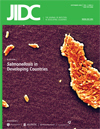The molecular epidemiology of Salmonella Typhi across Indonesia reveals bacterial migration
DOI:
https://doi.org/10.3855/jidc.548Keywords:
Salmonella Typhi, Typhoid fever, pulsed-field gel electrophoresis, molecular epidemiologyAbstract
BACKGROUND: Typhoid fever remains a worldwide problem, but it is particularly common in Southeast Asia, including Indonesia. The causative agent Salmonella Typhi is known to have significant genome plasticity. METHODOLOGY: This study describes genetic fingerprints using restriction fragment length polymorphism with SpeI of chromosomal DNA and pulsed-field gel electrophoresis (PFGE) of S. Typhi isolated from different geographic areas spreading from west to east across Indonesia. RESULTS: A total of 33 SpeI digested S. Typhi chromosomal DNA gave 22 schizotypes, 20 pulsotypes, and 12 subtypes indicating genomic diversity and the presence of more than one clone of S. Typhi. Cluster analysis at a degree of similarity of ≥80% showed four clusters, three of which were associated with geographic area. One cluster (Dice coefficient 0.727-1.000) contained isolates from three different geographic areas (Jakarta, Makasar, Jayapura), spread across Indonesia. CONCLUSIONS: Genetic fingerprinting of S. Typhi in Indonesia showed the presence of endemic strains in localized geographic areas, as well as the movement of one strain type throughout the archipelago.Downloads
Published
2009-09-15
How to Cite
1.
Moehario LH (2009) The molecular epidemiology of Salmonella Typhi across Indonesia reveals bacterial migration. J Infect Dev Ctries 3:579–584. doi: 10.3855/jidc.548
Issue
Section
Original Articles
License
Authors who publish with this journal agree to the following terms:
- Authors retain copyright and grant the journal right of first publication with the work simultaneously licensed under a Creative Commons Attribution License that allows others to share the work with an acknowledgement of the work's authorship and initial publication in this journal.
- Authors are able to enter into separate, additional contractual arrangements for the non-exclusive distribution of the journal's published version of the work (e.g., post it to an institutional repository or publish it in a book), with an acknowledgement of its initial publication in this journal.
- Authors are permitted and encouraged to post their work online (e.g., in institutional repositories or on their website) prior to and during the submission process, as it can lead to productive exchanges, as well as earlier and greater citation of published work (See The Effect of Open Access).








